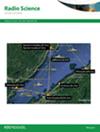Widening multi-beam scan angle of conventional waveguide lens antennas by increasing focal points for multi-feed excitations
IF 1.6
4区 地球科学
Q3 ASTRONOMY & ASTROPHYSICS
引用次数: 0
Abstract
This paper presents an alternative approach to improve the achievable beam scan angle of a traditional multi-beam waveguide lens antenna. Due to the focusing mechanism by manipulating the geometrical curvatures of the waveguide lens, the angular scan range is limited in the conventional waveguide lens design using dual-focal points of excitations because the geometrical curvatures of the waveguide lens only provide two design freedoms. To overcome this limitation, a solution of treating the waveguide lens as a transmit array consisting of non-identical elements is proposed so that each element of the antenna array can be well calibrated to improve the maximum scan angular range, where a third focus point of excitation can be created by adding another design freedom from the differentiation between non-identical elements. Each element of this new transmitting array can be well calibrated with the help of a mathematical expression to improve the maximum angular scan range. Numerical simulations show that the proposed antenna architecture exhibits better radiation characteristics than the traditional waveguide lens antenna. Radiation characteristics are studied and compared for both types of lens antennas to validate the design concept. The proposed triple-focal point provides a higher gain than the traditional lens antenna with fewer antenna elements. The gains of the beams at ±10°, ±20°, ±30°, and ±40° are found to be 27.78, 26.94, 26.19, and 24.04 dBi, respectively. From the comparison, it is seen that the variation in gain by the proposed triple-focal array design is more stable than the conventional dual-focal point design.通过增加多馈源激励的焦点来拓宽传统波导透镜天线的多波束扫描角度
本文提出了一种替代方法,以改善传统多波束波导透镜天线的可实现波束扫描角度。由于操纵波导透镜几何曲率的聚焦机制,在使用双焦点激励的传统波导透镜设计中,角度扫描范围受到限制,因为波导透镜的几何曲率只能提供两种设计自由。为了克服这一限制,我们提出了一种将波导透镜视为由非相同元件组成的发射阵列的解决方案,这样就可以对天线阵列的每个元件进行良好的校准,从而提高最大扫描角度范围。这种新发射阵列的每个元件都可以借助数学表达式进行校准,以提高最大扫描角度范围。数值模拟显示,与传统的波导透镜天线相比,拟议的天线结构具有更好的辐射特性。对两种透镜天线的辐射特性进行了研究和比较,以验证设计理念。与传统透镜天线相比,拟议的三焦点天线以较少的天线元件提供了更高的增益。发现±10°、±20°、±30°和±40°波束的增益分别为 27.78、26.94、26.19 和 24.04 dBi。从比较中可以看出,拟议的三焦点阵列设计的增益变化比传统的双焦点设计更加稳定。
本文章由计算机程序翻译,如有差异,请以英文原文为准。
求助全文
约1分钟内获得全文
求助全文
来源期刊

Radio Science
工程技术-地球化学与地球物理
CiteScore
3.30
自引率
12.50%
发文量
112
审稿时长
1 months
期刊介绍:
Radio Science (RDS) publishes original scientific contributions on radio-frequency electromagnetic-propagation and its applications. Contributions covering measurement, modelling, prediction and forecasting techniques pertinent to fields and waves - including antennas, signals and systems, the terrestrial and space environment and radio propagation problems in radio astronomy - are welcome. Contributions may address propagation through, interaction with, and remote sensing of structures, geophysical media, plasmas, and materials, as well as the application of radio frequency electromagnetic techniques to remote sensing of the Earth and other bodies in the solar system.
 求助内容:
求助内容: 应助结果提醒方式:
应助结果提醒方式:


